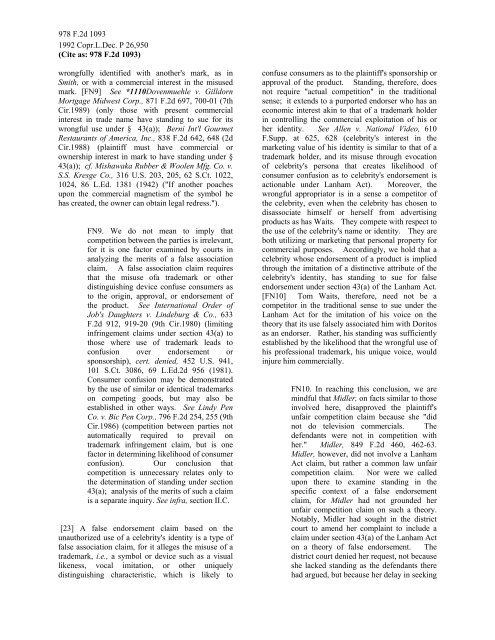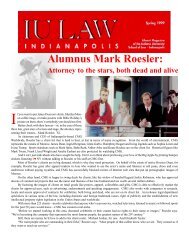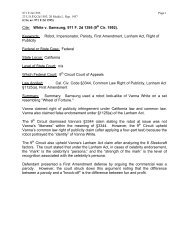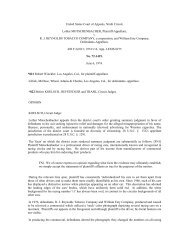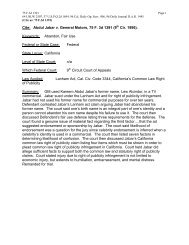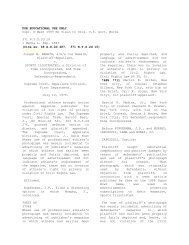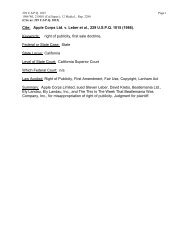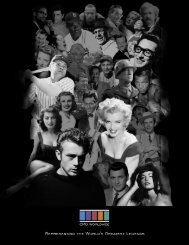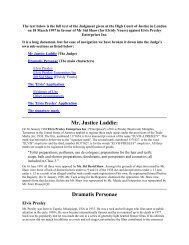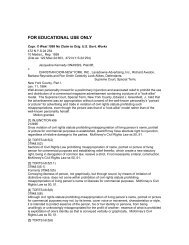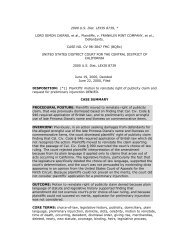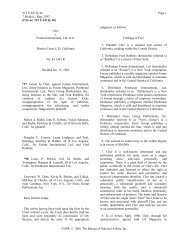Cite: Waits v. Frito Lay, 978 F. 2d 1093 (9th Cir. 1992 ... - Mark Roesler
Cite: Waits v. Frito Lay, 978 F. 2d 1093 (9th Cir. 1992 ... - Mark Roesler
Cite: Waits v. Frito Lay, 978 F. 2d 1093 (9th Cir. 1992 ... - Mark Roesler
You also want an ePaper? Increase the reach of your titles
YUMPU automatically turns print PDFs into web optimized ePapers that Google loves.
<strong>978</strong> F.<strong>2d</strong> <strong>1093</strong><br />
<strong>1992</strong> Copr.L.Dec. P 26,950<br />
(<strong>Cite</strong> as: <strong>978</strong> F.<strong>2d</strong> <strong>1093</strong>)<br />
wrongfully identified with another's mark, as in<br />
Smith, or with a commercial interest in the misused<br />
mark. [FN9] See *1110Dovenmuehle v. Gilldorn<br />
Mortgage Midwest Corp., 871 F.<strong>2d</strong> 697, 700-01 (7th<br />
<strong>Cir</strong>.1989) (only those with present commercial<br />
interest in trade name have standing to sue for its<br />
wrongful use under § 43(a)); Berni Int'l Gourmet<br />
Restaurants of America, Inc., 838 F.<strong>2d</strong> 642, 648 (<strong>2d</strong><br />
<strong>Cir</strong>.1988) (plaintiff must have commercial or<br />
ownership interest in mark to have standing under §<br />
43(a)); cf. Mishawaka Rubber & Woolen Mfg. Co. v.<br />
S.S. Kresge Co., 316 U.S. 203, 205, 62 S.Ct. 1022,<br />
1024, 86 L.Ed. 1381 (1942) ("If another poaches<br />
upon the commercial magnetism of the symbol he<br />
has created, the owner can obtain legal redress.").<br />
FN9. We do not mean to imply that<br />
competition between the parties is irrelevant,<br />
for it is one factor examined by courts in<br />
analyzing the merits of a false association<br />
claim. A false association claim requires<br />
that the misuse ofa trademark or other<br />
distinguishing device confuse consumers as<br />
to the origin, approval, or endorsement of<br />
the product. See International Order of<br />
Job's Daughters v. Lindeburg & Co., 633<br />
F.<strong>2d</strong> 912, 919-20 (<strong>9th</strong> <strong>Cir</strong>.1980) (limiting<br />
infringement claims under section 43(a) to<br />
those where use of trademark leads to<br />
confusion over endorsement or<br />
sponsorship), cert. denied, 452 U.S. 941,<br />
101 S.Ct. 3086, 69 L.Ed.<strong>2d</strong> 956 (1981).<br />
Consumer confusion may be demonstrated<br />
by the use of similar or identical trademarks<br />
on competing goods, but may also be<br />
established in other ways. See Lindy Pen<br />
Co. v. Bic Pen Corp., 796 F.<strong>2d</strong> 254, 255 (<strong>9th</strong><br />
<strong>Cir</strong>.1986) (competition between parties not<br />
automatically required to prevail on<br />
trademark infringement claim, but is one<br />
factor in determining likelihood of consumer<br />
confusion). Our conclusion that<br />
competition is unnecessary relates only to<br />
the determination of standing under section<br />
43(a); analysis of the merits of such a claim<br />
is a separate inquiry. See infra, section II.C.<br />
[23] A false endorsement claim based on the<br />
unauthorized use of a celebrity's identity is a type of<br />
false association claim, for it alleges the misuse of a<br />
trademark, i.e., a symbol or device such as a visual<br />
likeness, vocal imitation, or other uniquely<br />
distinguishing characteristic, which is likely to<br />
confuse consumers as to the plaintiff's sponsorship or<br />
approval of the product. Standing, therefore, does<br />
not require "actual competition" in the traditional<br />
sense; it extends to a purported endorser who has an<br />
economic interest akin to that of a trademark holder<br />
in controlling the commercial exploitation of his or<br />
her identity. See Allen v. National Video, 610<br />
F.Supp. at 625, 628 (celebrity's interest in the<br />
marketing value of his identity is similar to that of a<br />
trademark holder, and its misuse through evocation<br />
of celebrity's persona that creates likelihood of<br />
consumer confusion as to celebrity's endorsement is<br />
actionable under Lanham Act). Moreover, the<br />
wrongful appropriator is in a sense a competitor of<br />
the celebrity, even when the celebrity has chosen to<br />
disassociate himself or herself from advertising<br />
products as has <strong>Waits</strong>. They compete with respect to<br />
the use of the celebrity's name or identity. They are<br />
both utilizing or marketing that personal property for<br />
commercial purposes. Accordingly, we hold that a<br />
celebrity whose endorsement of a product is implied<br />
through the imitation of a distinctive attribute of the<br />
celebrity's identity, has standing to sue for false<br />
endorsement under section 43(a) of the Lanham Act.<br />
[FN10] Tom <strong>Waits</strong>, therefore, need not be a<br />
competitor in the traditional sense to sue under the<br />
Lanham Act for the imitation of his voice on the<br />
theory that its use falsely associated him with Doritos<br />
as an endorser. Rather, his standing was sufficiently<br />
established by the likelihood that the wrongful use of<br />
his professional trademark, his unique voice, would<br />
injure him commercially.<br />
FN10. In reaching this conclusion, we are<br />
mindful that Midler, on facts similar to those<br />
involved here, disapproved the plaintiff's<br />
unfair competition claim because she "did<br />
not do television commercials. The<br />
defendants were not in competition with<br />
her." Midler, 849 F.<strong>2d</strong> 460, 462-63.<br />
Midler, however, did not involve a Lanham<br />
Act claim, but rather a common law unfair<br />
competition claim. Nor were we called<br />
upon there to examine standing in the<br />
specific context of a false endorsement<br />
claim, for Midler had not grounded her<br />
unfair competition claim on such a theory.<br />
Notably, Midler had sought in the district<br />
court to amend her complaint to include a<br />
claim under section 43(a) of the Lanham Act<br />
on a theory of false endorsement. The<br />
district court denied her request, not because<br />
she lacked standing as the defendants there<br />
had argued, but because her delay in seeking


